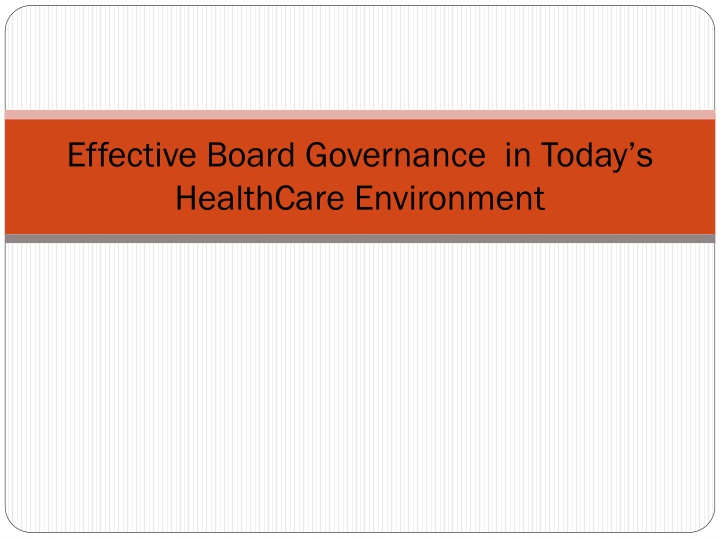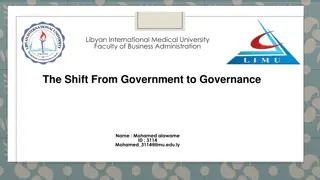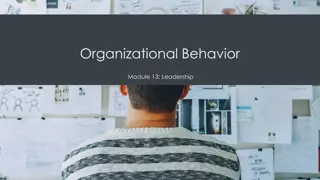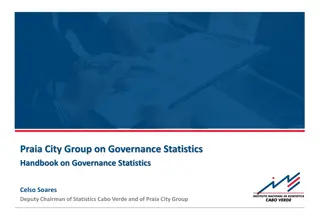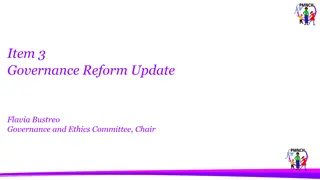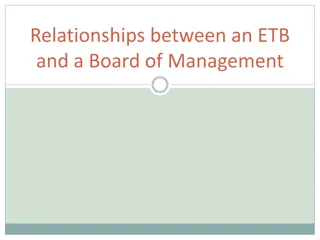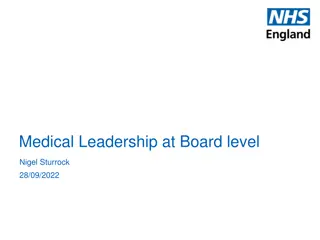Challenges and Governance Models in Healthcare Board Leadership
Explore the challenges and evolving landscape in healthcare governance, highlighting the importance of effective board leadership. Discover various governance models such as Advisory Board Governance and Patron Governance Model. Understand the skills required for board members to navigate the complexities of the healthcare environment.
Download Presentation

Please find below an Image/Link to download the presentation.
The content on the website is provided AS IS for your information and personal use only. It may not be sold, licensed, or shared on other websites without obtaining consent from the author.If you encounter any issues during the download, it is possible that the publisher has removed the file from their server.
You are allowed to download the files provided on this website for personal or commercial use, subject to the condition that they are used lawfully. All files are the property of their respective owners.
The content on the website is provided AS IS for your information and personal use only. It may not be sold, licensed, or shared on other websites without obtaining consent from the author.
E N D
Presentation Transcript
Effective Board Governance in Todays HealthCare Environment
The New World of Behavioral Health The New World of Behavioral Health The RAEs Value-Based Payment New Governor National HealthCare Policy Changes New Competition Consolidation Workforce Challenges Other?
The New World Will New Require New Skills Not Only for Management, But Also for Boards
Governance Governance is an amalgamation of policies, systems, and structures, along with a strategic, operational framework that aligns organizational leadership to take action, so that they can make effective decisions with accountability. A model for governance refers to how those policies, systems, structures, and framework interface with each other and whether the responsibility for them lies with the board as a whole, or with the individual board members Board Effect
Nonprofit Governance Models Nonprofit Governance Models Advisory Board Governance Model Patron Governance Model Cooperative Governance Model Management Team Model Policy Board Model Next? 1. 2. 3. 4. 5. 6. Board Effect
Advisory Board Governance Model An advisory board serves as the primary resource for the CEO to turn for help and advice. Members of an advisory board are trusted advisors who offer professional skills and talents at no cost to the organization. Advisory boards may also be formed in addition to an organization s board to help and advise the board, as a whole. Advisory board members typically have established expertise or credentials in the nonprofit s field. An organization that is visibly connected to an advisory board s name, can increase the organization s credibility, fundraising efforts, or public relation efforts.
Patron Governance Model The main difference between this and he Advisory Board models is that the primary purpose of the board members under the Patron Model is to perform duties related to fundraising. Patron Model boards are typically comprised of board members who have personal wealth or influence within the field. The primary role of board members under the Patron Model is to contribute their own funds to the organization and to use their network to gain outside contributions for the organization. Under this model, the board members have less influence over the CEO or organization s board than in the Advisory Board Model.
Cooperative Governance Model The board makes consensual decisions as a group of peers, making it the most democratic governance model. There is no hierarchy and no one individual has power over another. The board exists only because the law requires its formation. This model requires that each member be equally committed to the organization and willing to take responsibility for the actions of the whole board.
Management Team Model Rather than hiring paid employees to be responsible for human resources, fund-raising, finance, planning, and programs, the board forms committees to perform those duties.
Policy Board Model Policy Board Model The Carver model Boards establish policies, based on the organization s mission and values CEO and staff are responsible for carrying out those policies Ends versus means
What Do We Need Today? Critical Role of the Board is Developing Strategy with Both the CEO and the Executive Team For both Corporate and Non-Profit Boards
What Is Strategy? A set of coherent, coordinated actions and resources to gain sustainable competitive advantage
Board Process The Role of the Board Commitment Attendance Communication
The Role of the Board Board CEO Staff
12 PRINCIPLES OF GOVERNANCE THAT POWER EXCEPTIONAL BOARDS
1. Constructive Partnership Recognize that the effectiveness of the Board and the CEO are interdependent. Both the Board and the CEO welcome differing views and strategic thinking at the board table. Boards reserve to themselves organizational oversight and policy setting policy, and delegate to the CEO responsibility for managing operations and resources. While recognizing a division of labor, the Board becomes allies with the CEO in pursuit of the mission. Boards encourage a strong, honest executive to pose questions, offer answers and share bad news early and openly.
2. Mission Driven Ensure the congruence between decisions and core values. The board s job starts with putting into words why the organization exists and what it hopes to accomplish. As custodians of the mission, boards possess the boldness and courage to refocus the mission when necessary. Along with the staff, the board articulates the values of the organization and translates them into action.
3. Strategic Thinking Allocate time to what matters and continuously engage in strategic thinking to hone the organization s direction. Allocate the lion s share of board time to issues of consequence. Move away from report-laden agendas and carve out time for meaningful discussions about organizational strategy. Stay current with internal and external forces that drive strategic change within the organization. Strategically and continuously affirm the organizations mission, chart the future course and articulate priorities.
4. Culture of Inquiry Institutionalize a culture of inquiry that with mutual respect and constructive debate leads to sound and shared decision making. Create an environment of respect and candor. Exceptional boards seek more information, question assumptions and challenge conclusions. A culture of inquiry requires trust that comes from interactions and communication between board members.
5. Independent Mindedness Board members put the interests of the organization before all else. Boards should have a conflict-of-interest policy that precludes self dealing. Interact purposely with staff, other board members and outside stakeholders to gather information in pursuit of objectivity.
6. An Ethos of Transparency Ensure that donors, stakeholders and interested members of the public have access to accurate and appropriate information regarding finances, operations and results. Boards distinguish between the need for transparency and the importance of confidentiality to protect the organization s competitiveness and the reputation of individuals affiliated with it.
7. Compliance with Integrity Promote strong ethical values and disciplined compliance by establishing mechanisms for active oversight. The board ensures that the organization operates legally and ethically. Vigorous oversight is the norm.
8. Sustaining Resources Link bold visions and ambitious plans to financial support, expertise and networks of influence. Approve activities that can be realistic financed. In partnership with the CEO, ensure that the organization has the appropriate infrastructure it needs, such as highly qualified employees, adequate technology, capable volunteers and appropriate facilities. The board assists by being a community/networking resource for the organization.
9. Results Oriented Measure the organization s advancement towards mission and evaluate the performance of major programs and services. The board and management should agree on the critical indicators of the organization s performance and monitor the results. Be attentive to results so that the organization is flexible and can react quickly to changes in the environment.
10. Intentional Board Practices Drawing on bylaws, policies and traditions, boards create structures and practices that guide how they come together and function. Rely on ad hoc work groups to move forward on critical issues and take advantage of member s capabilities. Make meetings matter, rely on consent agendas and take accurate minutes.
11. Continuous Learning Embrace the qualities of a continuous learning organization, evaluating their own performance and assessing their own value to the organization. Ensure that all members attend formal orientation and have continuous educational opportunities. Provide members guidance in governance, nonprofit practices and the field of the organizations endeavor.
12. Revitalization Energize through planned turnover, thoughtful retirement and inclusiveness. Recognize the correlation between mission, strategy and board composition. Recruitment is continuous. Understand the importance of fresh perspective and the dangers of a closed group. Find creative alternatives to keep valuable members affiliated with the organization after the board term has expired.
